#coydog skull?
Text
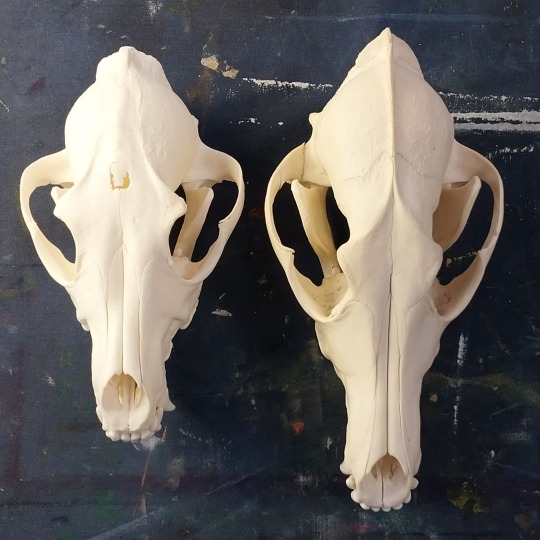
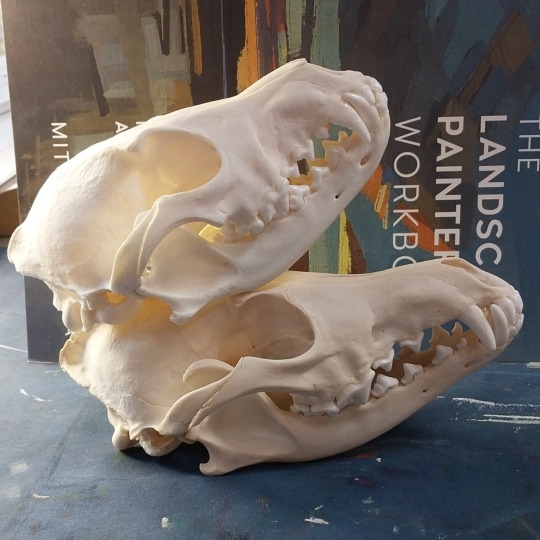


Oddball coyote skull.
These are both lestes subspecies (mountain coyote), from Eastern Washington. They lived within 150 miles of each other.
The pathologies on the smaller coyote are odd and have a few folks thinking there may be dog in its lineage. The stop, the muzzle, the interorbital width, the sagittal crest, the nasal bone shape... none of these are usual pathological features. The healing hole isn't too unusual but it doesn't seem to be from a typical wound.
Coyote experts out there, what do you think? @blackbackedjackal I'd love to hear your thoughts. What do we have here?
#coyote skull#pathological skull#vulture culture#animal skull#oddities#coydog skull?#pacific remains
139 notes
·
View notes
Note
Saw this on Reddit, could this be a coydog? https://www.reddit.com/r/animalid/comments/105o3g4/local_residents_page_in_mi_cant_decide_if_this_is/?utm_source=share&utm_medium=ios_app&utm_name=iossmf
I don’t know much about them as I don’t have coyotes in my country but I love learning form your account and seeing the massage variation in them, thank you for posting
So here's the picture of the coyote in question:

And images of the subspecies in that area, Canis latrans thamnos:


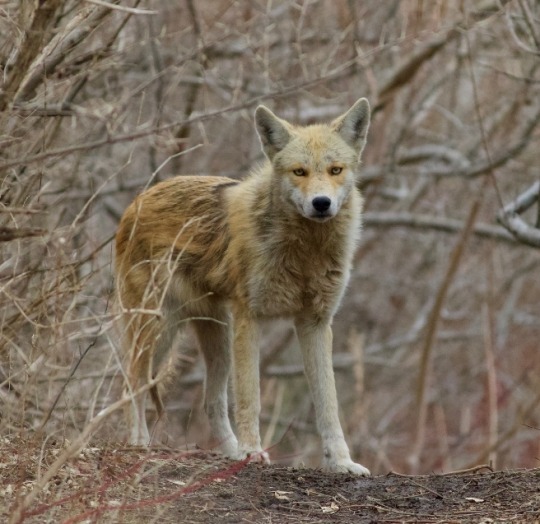


The Great Lakes/Northeastern coyotes are one of my favorite subspecies. They have a very unique skull shape and build since they're in this transitional space between the western subspecies and the Eastern Coyote (Canis latrans "var.").
Red coyotes are a very common morph among Eastern coyote subspecies. You see them in almost every Eastern state, and especially within the Northeastern subspecies. Though the theory is that this coloration was introduced into coyote population from dogs, many Northeasterns seem to be this color because it's just beneficial to the environment they live in. I'd need to find the image but there's a trial cam photo of a Northeastern coyote in the woods up there and it blends almost perfectly into the landscape. Coyotes are known for being incredibly adaptable and, as we've seen in Eastern Coyotes, if it's an adaptation they benefit from in a particular area, it spreads realtivly quickly through the populations. I've also wondered if because they look very dog-like from a distance is why you see a lot of them in urban environments (little bit of urban camouflage because the average person would see that color and think they're dogs, so they're left alone and can spread those genes). Here's a group of red Northeastern ones living in downtown Chicago:
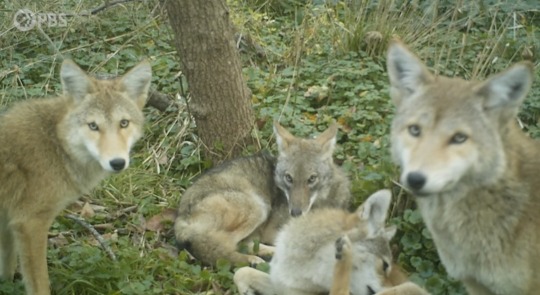
There's nothing about the image of that coyote to make me think it's a high content coydog. Read through a lot of the comments on reddit and all these "dog traits" people are looking at are just traits common within that subspecies. I haven't seen a ton of studies done on the Northeastern subspecies but the Eastern Coyotes which are more know for hybridization are still predominantly coyote with admixtures of dog, gray wolf, and eastern wolf within thier lineage. Basically, unless the animal is captured and tested, it's a safer bet to consider it a coyote until proven otherwise.
There was a black coyote that caused a big scene several years ago who was seen actively playing with and befriending dogs. The public was convinced he was a coydog because of his coloration and behavior. He was eventually captured and taken to a conservation center and samples from him were sent to UC Davis. No recent dog lineage was found. He was just a black coyote. His name's Carmine and he's adorable btw
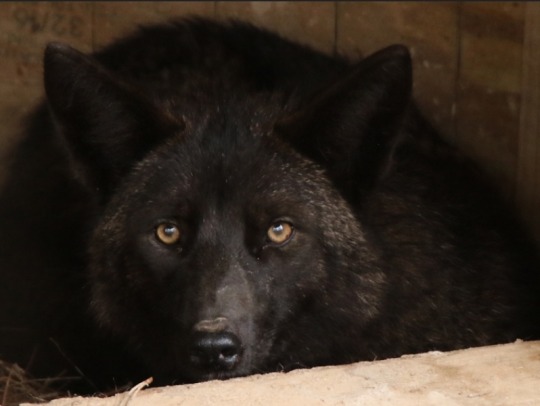
There's also this little lad who was tested and is confirmed to be an F1 coydog. From a distance he would look like a typical coyote, but he's half border collie.

Morphology alone is not the best indicatator for whether or not coyotes have high content of dog or wolf in them, especially if you aren't aware of the differences between the subspecies. Genetic testing is the only way to 100% confirm whether they do or not. Just from that one pic and knowing what area the coyote is from, I definitely think it's a just Northeastern coyote.
#coyote#color morph#I've worked on a lot of Northeastern coyotes#and they deffo have some funky traits and colors#but a coyote can be 99% coyote and look very wolfy or doggy#while an F1 hybrid can look just like a normal coyote#I have my own rubric and markers I look for when I work on yotes#if I notice anything sus I write it down as 'may have recent dog or wolf lineage TBT'#but until I can get those samples tested I can't say for certain#unless it's like#blatantly obvious which has only been a couple cases#ask
656 notes
·
View notes
Text
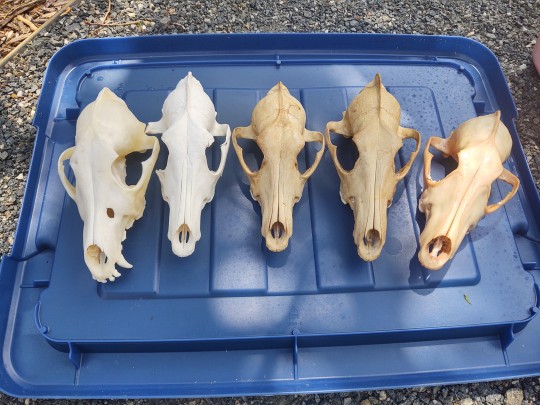

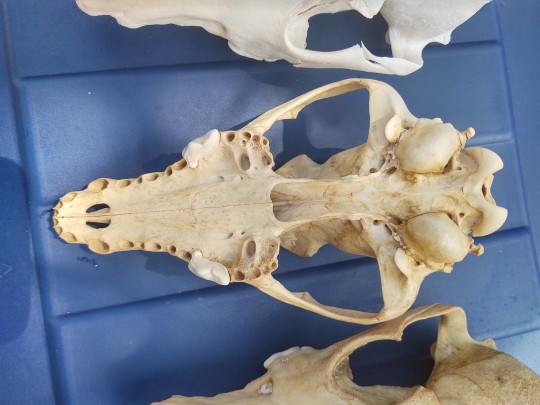
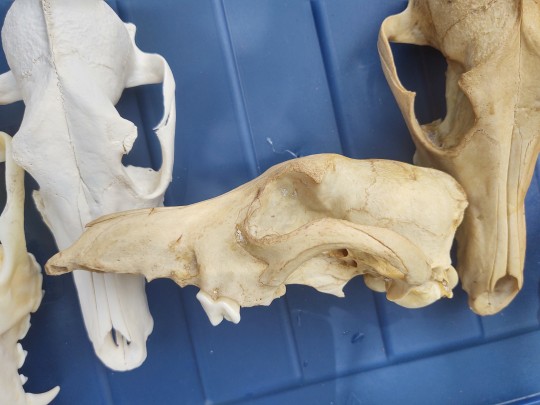
One of these things is not like the others....
Discovered this funky child (middle skull) and compared with my other yotes after I was about to put him in peroxide and wondered when I had gotten a dog skull. Perhaps a coydog? Or is it just a Strangely Shaped Child? Pretty small compared to my other yote kids, but I'm not experienced enough with them to tell much. It also has a really weird pathology that you can see on the (skull's) left side of the cranium.
@blackbackedjackal queen of the canines do you have any insights?
55 notes
·
View notes
Text
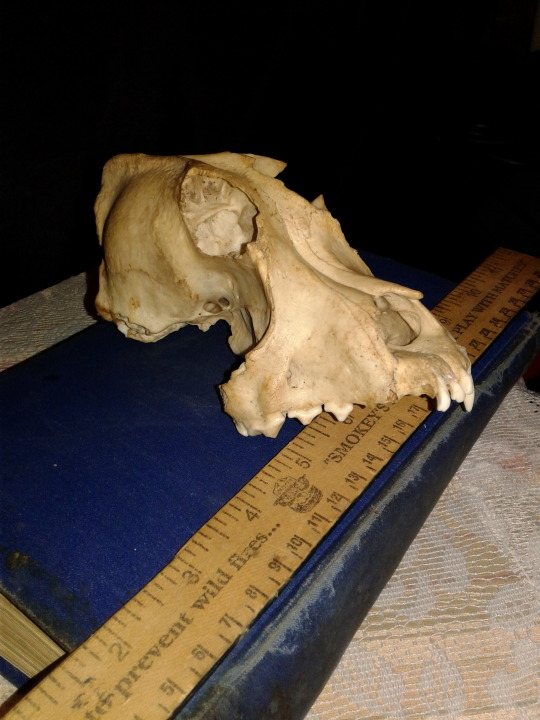
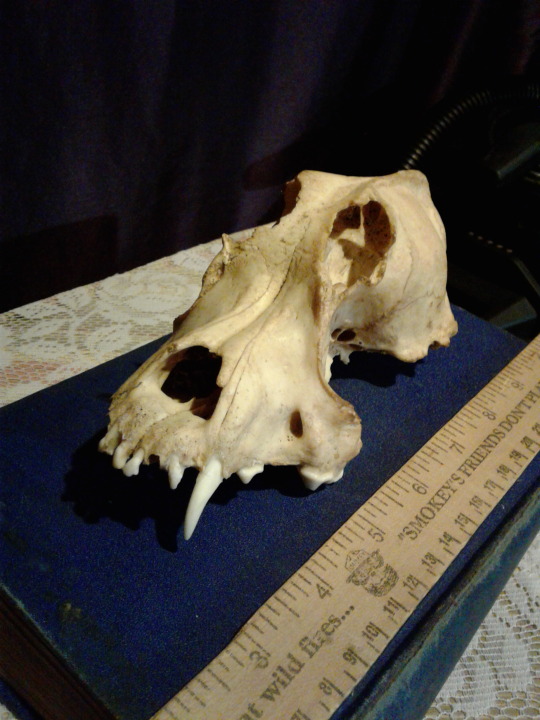
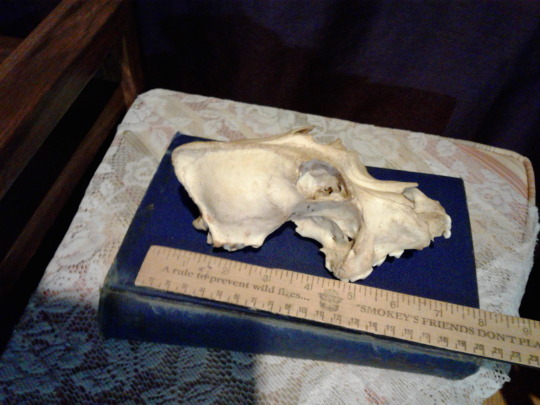
Can anyone help me id this skull? I was told it was a coydog skull but, it doesn't look like one. I named him, Cujo.
65 notes
·
View notes
Text
Cat and Dog Parts: What’s Legal, What’s Not? [in the US]
Alright so all the time I see people asking about cat and dog parts and there’s a LOT of confusion about what is and isn’t legal to buy/sell/trade/own. The laws are vague when it comes to us collectors because they weren’t made with us in mind, so I get it, it’s confusing. I’m hoping this little guide can help!
THE LAW AS IT IS WRITTEN:
(click here for the source)
(b) Prohibitions
(1) In general It shall be unlawful for any person to—
(A)
import into, or export from, the United States any dog or cat fur product; or
(B)
introduce into interstate commerce, manufacture for introduction into interstate commerce, sell, trade, or advertise in interstate commerce, offer to sell, or transport or distribute in interstate commerce in the United States, any dog or cat fur product.
(2) Exception
This subsection shall not apply to the importation, exportation, or transportation, for noncommercial purposes, of a personal pet that is deceased, including a pet preserved through taxidermy.
Click here to read more about laws regarding importing cat/dog fur (TL;DR: it’s illegal, don’t do it).
BONES:
To start bones are not covered by this law at all. Bones are legal. Skulls are legal. Teeth are legal. Even claws are legal (though some people still get iffy about those since they can be included with the pelt). Whether you have a single bone or fully articulated skeleton it doesn’t matter, the law does not target bones. It very specifically states fur and fur products.
TRANSPORTATION & SERVICES:
Another thing this law explicitly doesn’t prohibit is transporting or the changing of hands for pets for preservation purposes. Because some people want to have their pet preserved when they die, whether it’s to have their skull/bones cleaned for display, have their pet cremated, have their pet skinned out for a pelt, or have their pet mounted either traditionally or freezedried.
The important thing to remember is these aren’t animals being sold, only temporarily changing hands. You pay for the services, no one is buying/selling the pet itself.
While I have seen dog taxidermy for sale before, I’m not entirely sure of its legality, and could not personally find any information on this. It seems that if a family member who had a taxidermied pet passes away that mount can be inherited, but otherwise I’d love to chat with someone who knows more. To stay on the safe side I would avoid purchases or trades involving finished taxidermy products involving cats or dogs. These are cat and dog fur products that have the potential to create a market demand for dead cats and dogs. That’s entirely what the law is aiming to prevent.
People say it is legal to gift dog and cat pelts/products, but again this is something that’s probably best avoided. Just like you can legally gift bird parts from legally hunted birds that are otherwise covered by the MBTA, but people advise against doing so.
Interestingly, naturally shed pet fur also falls into this category. One neat thing people do with double coated breeds of dogs is spin their fur into yarn for knitting or needle felting with it. You can pay someone to make your dog’s fur into yarn, or even create a finished product with it, but you can’t sell already-made shed fur products.
WET/OTHERWISE PRESERVED SPECIMENS:
The logical conclusion most would reach from this law is that anything with cat and dog fur or leather is 100% off-limits. But that’s where things get tricky.
Surprisingly, this law was not intended to target otherwise preserved cats and dogs. That’s why you can find biomedical supply websites that sell cats and dogs that are preserved via injections (like formaldehyde/formalin), and why many people can recall dissecting cats in school. That wet specimen fetal puppy you saw over on Facebook is, in fact, legal.
So why is this, you may ask? After all, the law very clearly states any product containing cat and dog fur is explicitly illegal, and those full specimens certainly contain fur.
That’s when you look at the spirit of the law rather than the letter of the law.
The law was meant to target products that were being imported into the US that were labeled as other furs (fox, rabbit, wolf, mink, synthetics, etc.) but were actually dog and cat fur, mainly fur garments and accessories or even toys. As you can imagine this didn’t go over so well here in the states when it was discovered. There was evidence that cats and dogs were even being bred for this express purpose. Not only were people outraged about the fact that it was cats and dogs being used, because we love them so dearly as pets, but people were also mad because this was dishonest business that mislabeled furs in an attempt to make more money. A dog is easier and cheaper to obtain than a wolf, for example. Whether you cared about the ethics of the fur involved or the ethics of business this was a very big deal.
So because this was the target which the law was focused on stopping, otherwise preserved specimens which would not be suitable to make your traditional fur products with weren’t really meant to be restricted. After all, those preserved specimens are still argued to be valuable in the science and medical fields as educational tools. Most people would not say that the fur from a preserved whole specimen is usable (though I have seen people claim to skin and successfully tan wet preserved animals...that said this would not be cost or time effective so because of those factors this is not something the law is really focused on).
Of course this can change, or you could run into a law official who takes special issue with you and uses the letter of the law against you. While I’ve never heard of this happening I wouldn’t rule it out. Erring on the side of caution is never a bad thing. Just don’t harass someone for doing this.
HYBRIDS:
Now what about wolfdogs or coydogs?
These hit a legal gray area, because federally and in most states they are not considered to be “dogs”. They are considered exotic pets or even just wild animals, that’s why the rabies vaccine is not legally considered viable to them. Not to mention you could potentially find both in the wild that were born wild (and these could be considered a nuisance rather than native animal). Plus it may be difficult to prove what you actually have does have dog in it.
If the canine you possess looks more coyote or wolf than dog, you’re probably fine (so mid-to-high content only, essentially). Some doggy characteristics do appear in wild animals, such as black and tan coyotes that are not coydogs (yes this is a coloration that can happen). If they look very dog-like you may want to pass it up, because people can argue that it’s a pure dog. Study your anatomy and the differences between dogs and coyotes and wolves.
PARTS:
If you have leather or a pelt these are definitely off-limits. You may not buy, sell, or trade them. Even gifting is ill-advised. This includes everything, whether it’s a full pelt, a fur trim, a leather bag, a dried paw, a tail, whatever. It doesn’t matter if it is the whole animal or a piece of them, it is off limits.
OWNING CAT/DOG FUR:
Owning cat and dog fur can be done legally. Again, the law doesn’t want to prohibit people from owning their pet’s remains. It is perfectly legal to keep your deceased pet in any state, preserved or not.
This is where you’ll see people trying to collect roadkill domestics, or even try to pester their local veterinary offices or shelters for carcasses (note: most will tell you no, or it can actually be illegal for them to give you animal remains).
Pets are legally classified as property. As such taking someone’s cat or dog, dead or alive, is stealing. Now if it is your pet it is your legal property. Likewise if you find a lost or deceased pet many states have legal holding periods. You must try to find an owner during that period. And by try I mean contacting shelters/animal control, putting up listings, asking around, looking at lost pet listings, etc. You cannot just nab an animal and wait it out. With live animals you usually have to go through an adoption process through a shelter before the pet is actually considered to be yours.
With dead animals it’s a bit more tricky and controversial. Many people pick up roadkill and, when no owner is found after no less than a month of searching, will just keep it without notifying authorities. This is because in most cases said authorities will want to dispose of the corpse for you, which people intent on keeping said body parts are trying to avoid (you can still try to ask and see). This is why it’s controversial. Technically if you keep the animal past the legal holding period without finding an owner while actively searching the animal is not considered to be the original owner’s pet anymore. Most animals people pick up are strays (particularly cats) in areas known to have strays, some of these strays being known as such before finding them dead. It is not illegal to keep the fur/leather from these animals, but its something other people will likely challenge you about.
Keep documentation of any animal you pick up. Put in a found report with your local shelters. Hold onto them. For more about this topic see my other post, I Found a Dead Cat/Dog.
BOTTOM LINE:
Bottom line is if you’re not sure assume it’s not legal. It’s better to be safe than sorry. If you see someone doing something and you’re not sure it’s legal, privately message them and ask. If you see someone doing something that is definitely illegal, contact them and find out if they know what they’re doing is illegal. If they know it is and continue to do it anyway then yes, please report them.
Also please remember this post only applies to people in the United States of America. Other countries have different laws. Do not harass someone from a different country unless you know for certain they are violating their country’s laws, or are trying to do business with someone from the US in a way that would violate our import laws.
I hope people find this helpful. Please feel free to add on to this post or correct any information or anything else.
THIS IS NOT INTENDED TO BE LEGAL ADVICE. PLEASE DO YOUR OWN RESEARCH AND ASK YOUR OFFICIALS.
146 notes
·
View notes
Photo


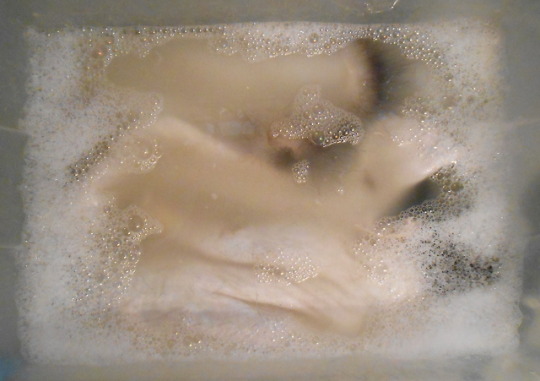
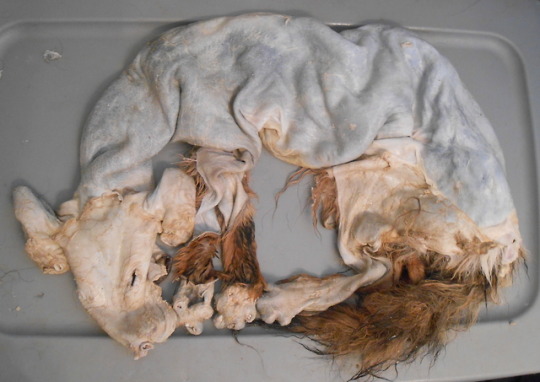
today’s taxidermy/tanning tasks:
-pulled a couple skulls out of maceration and got them in the degreaser, a ranch fox and grey fox. they’ll be for sale when they’re done!
-degreased a cat, 2 possums, and a ferret. now they’re ready to tan!
-started detail fleshing a client’s coydog. i was determined to finish him in one go but then my dad had guests over so i had to stop haha
-continued breaking the leather on the yote i started yesterday
27 notes
·
View notes
Note
Do you have a database kind of thing for pictures of your dog skulls or your pathological animals? I know you have a decent amount of both and I was just curious if there was a place where they were all readily available
I don’t at the moment, but I really want to once I’ve got my personal skulls done! I’ve got a few coyotes degreasing, my coydog is degreasing, and there are some dog skulls degreasing too. I’m HOPING that with the incoming heat, that my degrease kicks up and I don’t have to limp along using a tank heater. So maybe in a few months I’ll take extensive pics of all my skulls so people can use them for reference or for science/research reasons!
8 notes
·
View notes
Photo


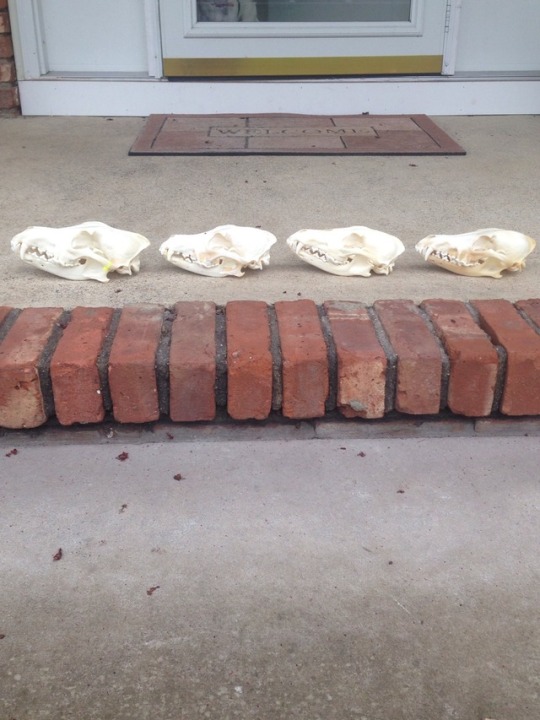
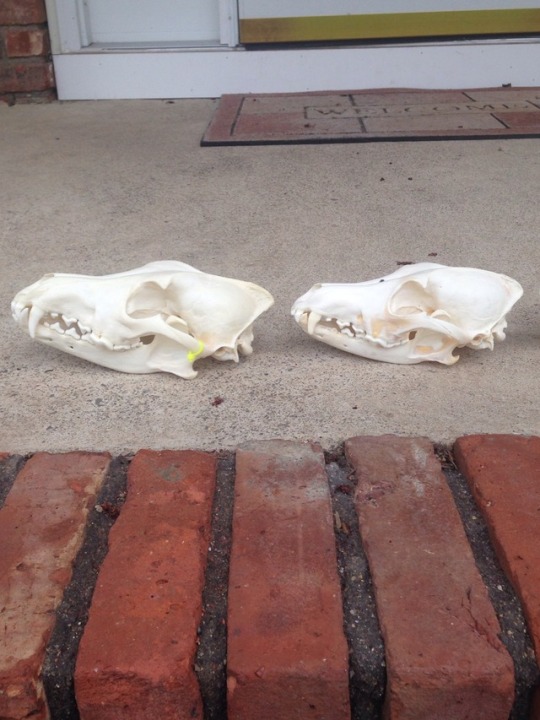
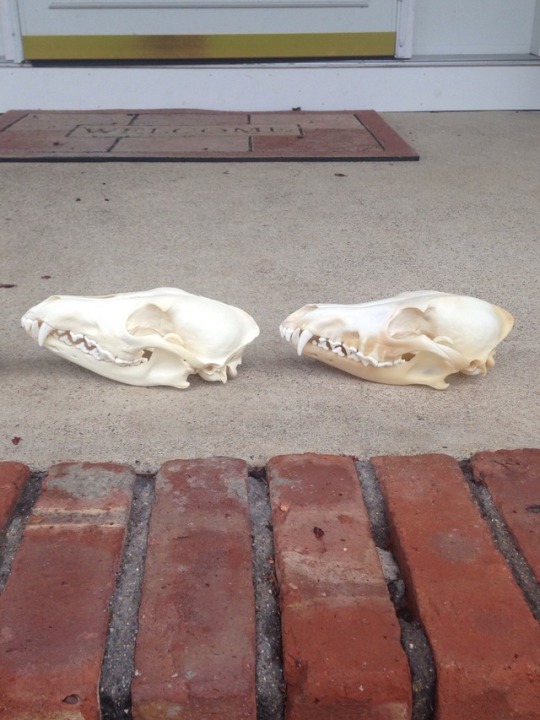

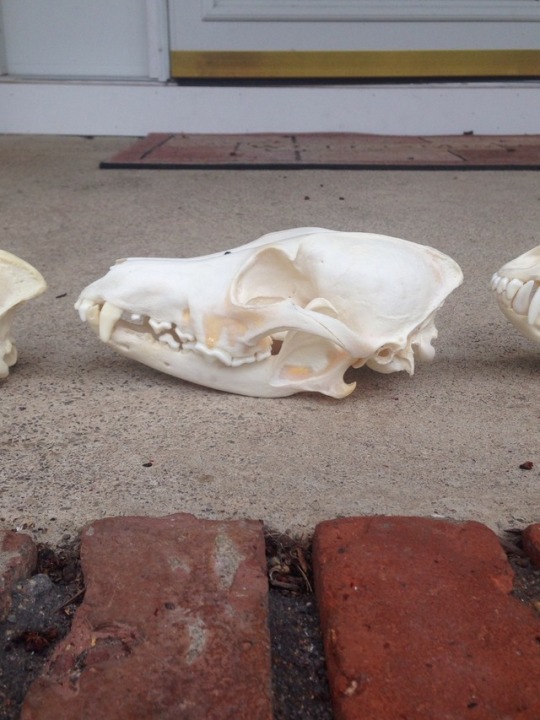
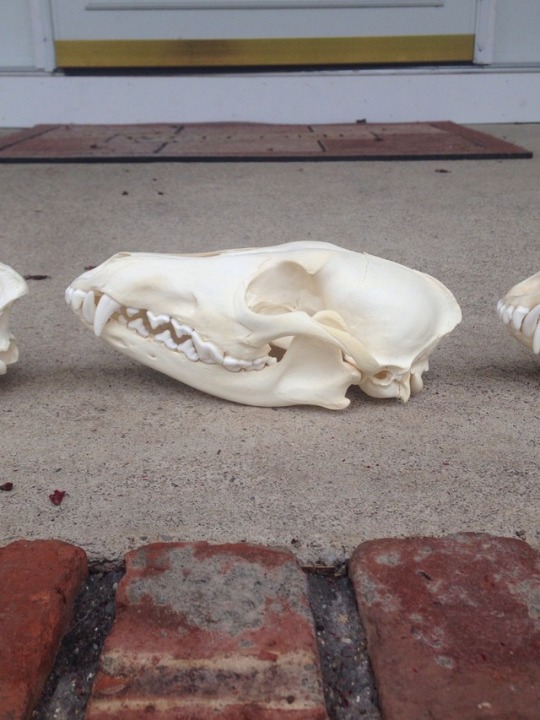
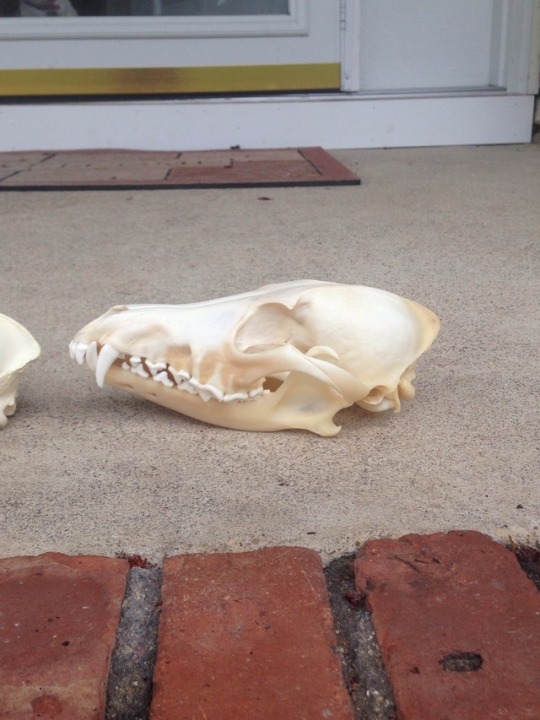
Coyote Skull Comparison
Coywolf (Arlo) | Coydog (Rogue) | Coyote (Zen) | Coyote (Buckshot)
#taxidermy#vulture culture#dead stuff#dead animals#skull#skulls#animal skulls#coyote skull#reference
78 notes
·
View notes
Note
Random question! Why don’t I see many coydogs that look like their dog parent was some sort of hound or bull breed type? I figure in some areas those types would be more common to find unneutered? Is the coyote flavor just more dominant, or are they somehow only mating with spitzes or shepherds? I’d love to see some with dog traits that are not from ‘wolfy’ breeds if you have any pictures!
I'll answer this in more detail when I'm back in town but I do have a couple examples of coyote x bully type dogs in my research collection.
First off is Zephyr. Compared to normal coyotes she has a very short and wide muzzle. Her ears are small and curled (meaning her ears were likely floppy), and she has a brindle coat color. All of these traits line up with her being a coyote mixed with a bully breed.
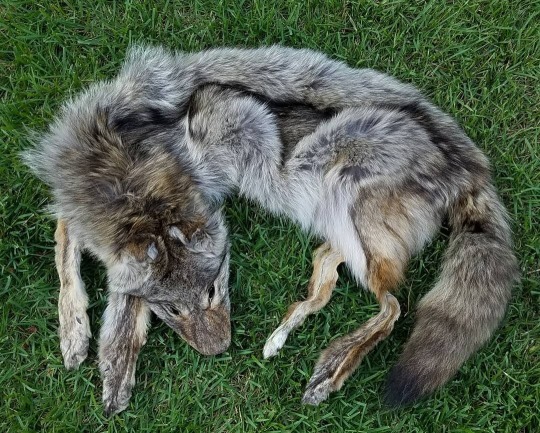
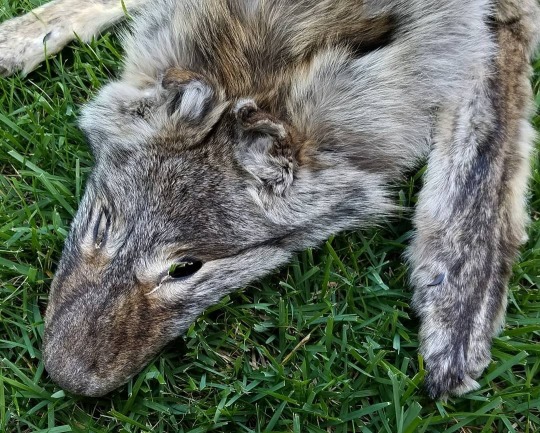
Second is this skull of a coyote x APBT mix. The skull was cleaned by the seller so I know the ID is accurate. Like Zephyr, the muzzle is shorter than a normal coyote and has a more defined stop and rounded cranium.
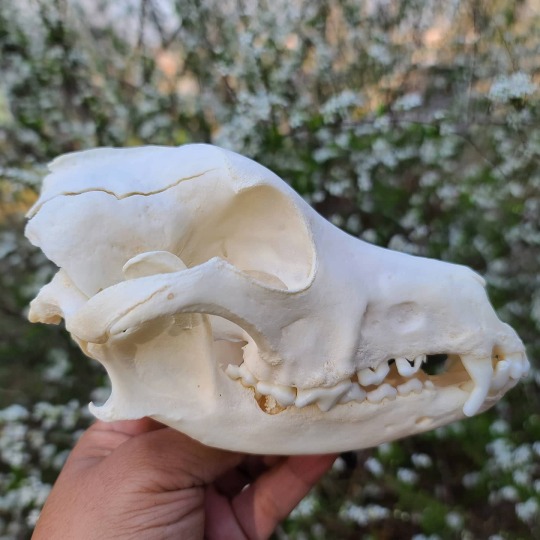
Why these crosses don't seem to be as common is a bit complicated and I'd need to make sure I have all my sources and confirmed coydog photos lined up to fully answer the question. But short version, the coyote genes seem to be dominant in most cases (especially in the face, tails, and coat color) and many "coydogs" online are mislabeled and are coyotes that have dog ancestry with color morphs and other traits that were introduced into the populations.
#ask#you can have coyotes that are like#99% coyote but have color morphs that were introduced into the genepool by dogs#which makes them look like a coydog but it's not like#a literal coyote x dog cross#also it has to do with the differences in mating/gestation/parenting between dogs and coyotes#and which populations/areas the coyotes and dogs are present in
37 notes
·
View notes
Note
Any tips on finding canines to add to the collection? Do you just get lucky enough to find things like your coydog bullies or is there some kind of search term?
Additionally, do you ever sell anything? Canine or not
Honestly, it all just adds up to the fact that I've been collecting for over 10 years. Defiantly had a lot of luck, but I've been diligent about collecting since the beginning which has just added up over time. Canines are very common in the US market so there's been a lot of opportunities to find some really interesting ones :>
I also had to learn how to collect, if that makes sense? Stuff like pricing, availability, learning how to budget, and being able to accurately identify different canids, etc. I can't tell you how many "coyote" pelts and skulls I bought that were actually wolves, dogs, or foxes. And even then, there's still a few surprises lol
I've gotten a lot from people in the VC community and friends/followers that send me things they're selling or saw while they were looking for their own critters. I also have a network of local people that will contact me if they see anything or when they go out hunting/trapping. Other than that, I mostly just check ebay and etsy at random or go scavenging for my own stuff.
And I do! I try to do sales about once a month. I've been processing a lot of other critters recently but I usually have some canids for sale :>
14 notes
·
View notes
Text
An incisor fell out of my aardwolf skull while I was rearranging a cabinet and my first logical way to get it out from under there was with a coydog baculum.
45 notes
·
View notes
Note
Hey there! Not questioning, just curious and wanting to learn! But in your recent post about the coydog/coywolf skulls; what markers does the coywolf skull show to let you know it's coywolf? I can easily enough identify that the other skull has very doggy characteristics, but I'm unsure what to look for in the wolfy one... Sorry, and thank you <3

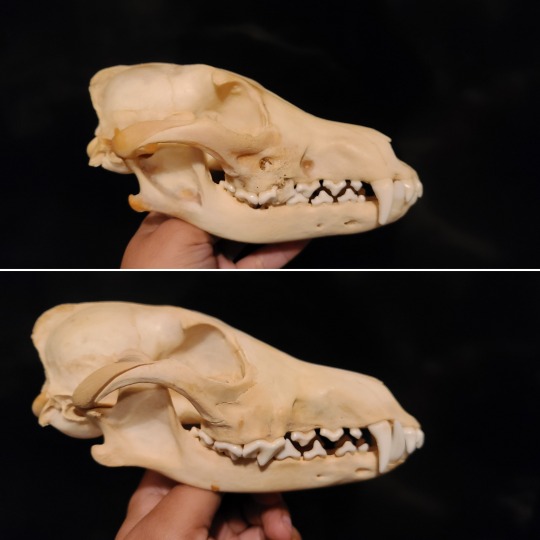
No problem! These are my favorite kinds of questions lol.
Took some pics for ya. The left one is the coywolf on top and an Eastern wolf on the bottom. The right is the coywolf compared to the nominate coypte subspecies Canis latrans latrans. You can see how many traits of the wolf show up in the profile, as well as the coyote. The skull is also super dense, much like wolf skulls but not like coyotes where even the largest ones I have are not nearly as dense or heavy feeling as this guy. This includes Eastern coyotes which do have wolf DNA in their gene pool, which is not the same as high-content coyote/wolf hybrids.
37 notes
·
View notes
Text
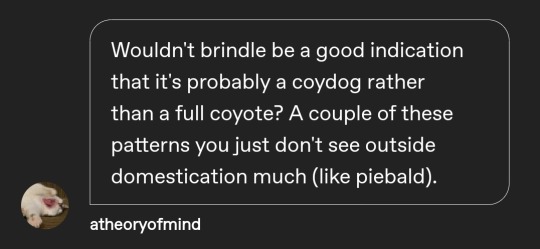
The short answer is no. A significant chunk of coyotes have some dog or wolf ancestry, but that doesn't make them coydogs, coywolves, or coywolfdogs lol. It's theorized many morphs, such as black and red coyotes, owe thier colorations to dog genetics being introduced into the species, but the morphs can happen many generations later when there's only a bit of dog present. It's the reason I'll use terms like 'recent dog ancestry' rather then saying it's a coydog off the bat for many of the coyotes I have. The only way to say for sure if it's a coydog or coywolf is to have seen the animal/processed it yourself or have the skull of said animal. Skulls are by far the easiest way to tell if it's a high content hybrid.
#reply#there's other ways as well to tell but it's like#something I'd have to take pictures of my coydogs to explain#pelts are much harder but I've seen some consistencies#I'd just have to pull them out and post them later to explain
29 notes
·
View notes
Text
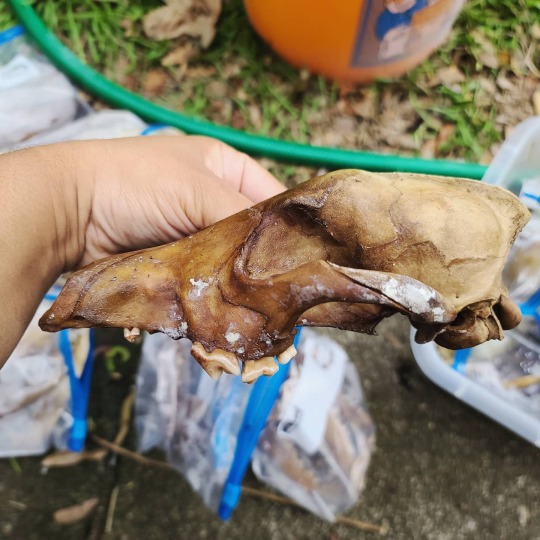

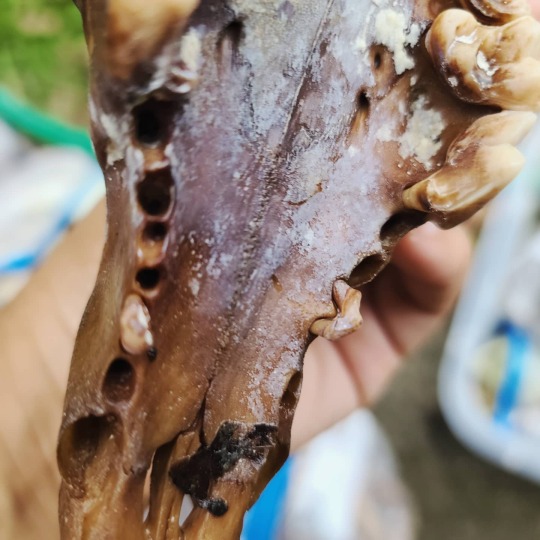
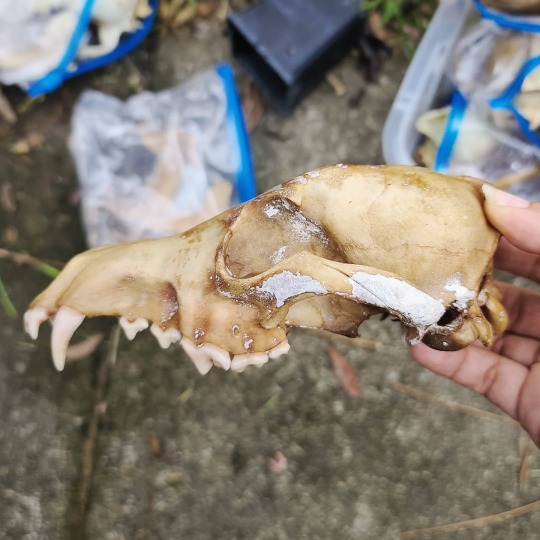
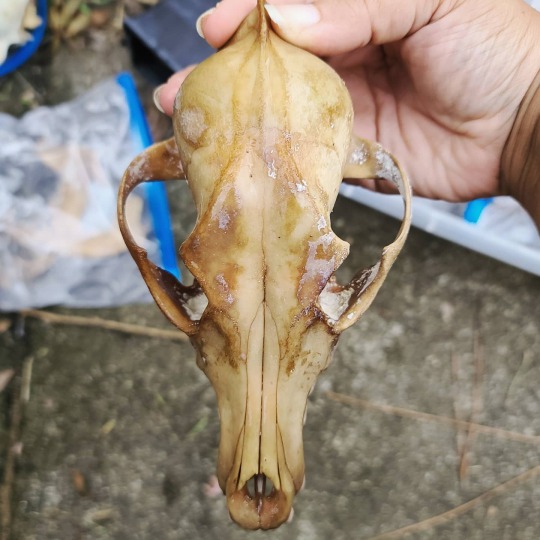
Couple of weirdos in the next skull batch! Tiny Tooth Adventures and The Brain. They still need a few weeks of cleaning before I can get a good look at them. I think The Brain is prolly a coydog or has some recent dog lingage as they don't match the general profiles of the subspecies in the area they came from. Tiny Tooth is just weird?? He almost looks like he has raccoon or red fox teeth instead of coyote ones. The roots of his premolars are fused as well.
35 notes
·
View notes
Text
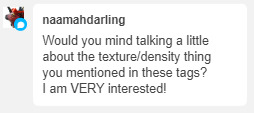
@naamahdarling Wolves have very dense and heavy feeling bones compared to dogs and that density is also present in high content wolf hybrids or animals with recent wolf genetics in their lineage (wolfdog skulls and some eastern coyote/coywolf skulls). Dogs also tend to have a rougher texture overall to their skulls than coyotes/wolves. It’s almost like the texture difference between like 80g sandpaper and 100g, it’s subtle but it’s there. I’ve felt that texture crossover on the wolfdog and coydog skulls I have, especially on the cranium and around the gumline. It’s just something I’ve noticed while messing with in my own collection. I can’t say for sure if it’s like a legitimate method for identification, but the hybrids to me do feel like combinations of the textures/densities of the animals that make them up.
#replies#it's easier to explain when you can actually handle the skulls#dogs/coyotes/wolves just feel different from one another
38 notes
·
View notes
Text
So Stubby is one of the largest coyotes I've seen in my state and I'm super excited to get him fully cleaned. His broken leg is in the degrease now while the rest of him is macerating, and his tail will go in the beetle bin soon so I can get a good look at the injury. I would articulate him and may do so in the future but he's so interesting for comparative purposes I may just keep him sorted for now to take pics of all his individual pathologies.
Protag (the coydog) I'm also super excited about since there's not really any documentation on the entire skeleton of a coydog vs a coyote. I've had a coydog skull for years but I've never seen a full skeleton cleaned up. So far it looks like there is a reasonable amount of differences between them and coyotes.
And lastly I was doing some research and if the C. l. frustor turns out to be a furstor, which at this point I'm more certain it is but I have to wait until the skull is clean, it actually makes a lot of sense that it traveled as far as it did before being hit. Coyote subspecies are seperated by thier prefered habitat so since it was a young coyote it was probably looking for new territory similar to the region it was born in. If it came from the easternmost part of Frustor territory, it would have traveled about 150miles which isn't too crazy, or since the subspecies territories were last documented frustors could have moved more east. Either way they've never been documented in this area in the last 60 years of research, so it's an exciting find to say the least.
#jackal's journal#coyote updates#my brain is buzzing with all this information#coyote are cool as fuck and i love studying them they're just#such a crazy species
35 notes
·
View notes